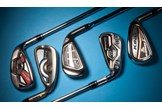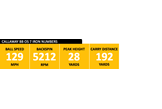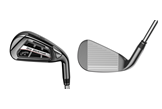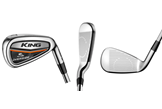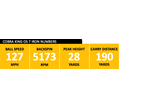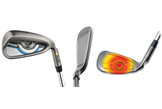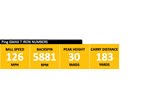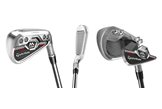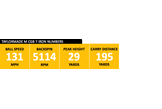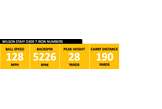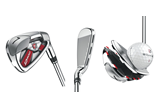REVIEW: Uber-forgiving irons
Published: Last updated:
Super-forgiving irons have a reputation for being ugly ducklings, with big heads that look more like oars than clubs. Admittedly uber forgiveness in the past has come with trade-offs, usually in the form of wide soles, huge cavity backs and top edges thicker than a sumo wrestler’s loincloth.
But trust us, looks and cosmetics are now a serious consideration for the designers of ultimate forgiveness irons, and today’s models are nicer looking and better performing than ever. After TaylorMade launched the M CGBs – their first set to feature just as much face flex (from every iron in the set) as a driver – we thought the time was right to revisit the super game improvement category, and put the CGBs up against the best super game improvement irons of 2017.
How we did it:
As uber-forgiving irons aren’t really aimed at pros, we got both TG Equipment Editor Simon Daddow and TG test pro Chris Ryan to hit each on a launch monitor. To ensure an accurate comparison (thanks to his repeatable swing) we’ve only published Chris’s test data to show how each model performed against its peers.
Review: Ping GMax iron £92 (s) £102 (g)

Availability: 4-SW
Stock shaft: Choice of six premium options
7-iron loft/length/offset: 30.5° loft / 37” length / 6.6mm
Verdict:
The GMax is now over two years old, so considering how fast tech is moving, competing against the very latest model in terms of ball speed and carry was likely to be a big ask, especially from a weaker lofted 7-iron (1° compared to the CGB). The GMax has a long, wide head (toe to heel), which helps raise MOI and forgiveness over a more compact head. In terms of protecting ball speed the GMax’s shape does what it’s supposed to, registering the lowest ball speed drop-off (6mph) here test. The custom fit options are fantastic and you can buy each iron individually.

Review: Cobra King Oversize iron £699 (s) £799 (g)

Availability: 4-PW (stock set 5-PW)
Stock shaft: True Temper XP-85 (s) UST Recoil 460 (g)
7-iron loft/length/offset: 30° loft / 37.25” length / 4.5mm
Verdict:
Hollow-headed constructions (like the Oversize) are becoming more popular nowadays, primarily because engineers have realised how they can make a decent looking head and combine it with the levels of forgiveness you’d expect from a hybrid. 50g-70g of tungsten low in the toe offers excellent off-centre hit stability and while our test pro wasn’t a fan of the circular groove pattern (in the centre of the face), the looks and performance did force him to question why more of us (himself included) don’t use such forgiving irons. By recording an average 190 yards (7-iron carry) the Cobras certainly hold their own for distance and forgiveness.

Review: TaylorMade M CGB iron £849 (s) £1099 (g) 7 irons

Availability: 4-SW
Stock shaft: Nippon NS Pro 840 (s) UST Recoil 460 ES (g)
7-iron loft/length/offset: 29.5° loft / 37” length / 4.7 mm
Verdict:
We don’t know how they do it, but when it comes to delivering on distance and speed TaylorMade very rarely lets you down. Yes, the M CGB is the latest, most up to date model here (with the joint strongest 7-iron loft), so it’s fair to expect it to be the longest, but hands-down it delivered the fastest ball speeds and longest carry. We particularly liked the head shape and sizing; it’s a far cry from the shovels many golfers think are the norm at this end of the market. Just like the other irons on test the CGBs feature slightly lighter shafts (80g in steel) which add a much-needed boost to club and ball speeds for the target golfer. TaylorMade says the CGBs are particularly good at average and lower swing speeds (as they launch higher and stay in the air for longer) and we’d agree. The faces feel light and lively, which for lots of club golfers would mean more distance and enjoyment on the course.

Review: Wilson Staff D300 iron £579 (s) £659 (g)

Availability: 4-PW, GW
Stock shaft: KBS Tour 80 (s) Matrix Speed Rulz A-Type (g)
7-iron loft/length/offset: 29.5°/37.50”/ 5.2mm
Verdict:
Power hole tech means only 24% of the D300’s face is connected to the body, which Wilson says improves face flex and rebound. We’d agree the tech works, as a 190-yard average carry (with a 7-iron) is right up there with the more expensive models here. Our pro felt ball flight was a little less consistent, with shots hit lower in the face (where most flex occurs) spinning up higher than shots hit further up the face. With the biggest difference in shot height (12 yards) for all the irons tested, our data supports the pro’s theory, too.

Review: Wilson Staff D300 iron
Review: Callaway Big Bertha OS iron £849 (s) £1099 (g)

Availability: 4-PW
Stock shaft: True Temper Speed Step 80 (s) UST Recoil ES 460 (g)
7-iron loft/length/offset: 30°/37.25”/5mm
Verdict:
Iron heads just weren’t made like this a few years ago. A cage-like construction removes every last gram of weight from areas you really don’t need it, which means fantastic forgiveness from the Big Bertha’s slightly smaller, more compact head. The OS is one of Simon’s favourite irons of 2017 purely because it’s an uber-forgiving design with a look you just don’t expect from such an iron. The construction method is expensive, so these don’t come cheap. But in terms of power, speed and preserving distance when shots aren’t hit from the centre of the face, it is right up there with the very best.



